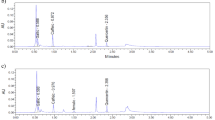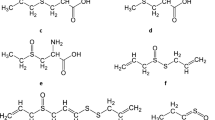Abstract
Garlic has been used worldwide as a folk medicine to cure a wide range of diseases. AlthoughAllium sativum is the species commonly used, several otherAllium species have been used as a substitute for common garlic, especially in the past. This work compares the extracts from bulbs of common garlic with those of otherAllium species. TLC analysis was used to compare the sulphur compounds inA. sativum, A. subhirsutum, A. pendulinum, A. roseum, andA. triquetrum. Results have showed that the use of the above mentioned wildAllium species is not without scientific support.
Résumé
L’agilo é stato usato umversalmente in medicina popolare per curare un ‘ampia gamma di patologie, SebbeneAllium sativum é la specie comunemente piú usata, é noto che altre specie diAllium sono state usate come suoi sostituti nel passato. Questo lavoro ha riguardato la comparazione di estratti di bulbi di aglio comune con quelli di altre specie quail A. subhirsutum, A. pendulinum, A. roseum, eA. triquetrum; in particolare é stato paragonato il diverso contenuto di composti solforati utilizzando la técnica della cromatografia su Strato sottile. I risultati hanno evidenziato che I’utilizzo dette su citate specie non é privo di fondamento scientifico.
Similar content being viewed by others
Literature Cited
Creutz, R. 1929. Der Ant Costantinus Afrikanus von Montecassino, in “Studien mid Mitteihingendes Benediktiner Ordens”, Pp. 1–44.
Cronquist, A. 1982. An integrated system of classification of flowering plants. Columbia University Press, New York.
Ebers, G. 1875. Papyros Ebers: Das hermetische Buch über die Arzeneimittel der alten Agypter in hieratische Schrift. 1–2. Leipzig (vol. 1 repr. Osnabrück: Biblio Verlag, 1987).
Efendy, J. L., et al. 1997. The effect of the aged garlic extracts ‘Kioloc/rs on the development of experimental atherosclerosis. Atherosclerosis 132:37–42.
Flaccomio, F. 1950. Farmacologia dell’aglio. Rivista italiana essenze e profumi 3:108.
Kyo, F., et al. 1997. Anti-allergic effects of aged garlic extracts. Phytomedicine 4(4):335–340.
Landis, K. 2001. Hildegard von Bingen. Ricette per il corpo e per l’anima. Guido Tonunasi Editore, Milano.
Nagae, S., et al. 1994. Pharmacokinetics of the garlic compound S-allylcysteine. Planta Medica 60: 214–217.
Nagatoshi, I., A. B. Nelson, and B. H. S. Lau. 1997. Aged garlic extracts and its constituents inhibit Cu2+ induced oxidative modification of low density lipoprotein. Planta Medica 63:263–264.
Pignatti, S. 1982. Flora d’ltalia 3:379–394. Edagricole, Bologna.
Pinto, J. T., et al. 1997. Effects of garlic thioallyl derivatives on growth, gluthatione concentration, and polyamine formation on human prostate carcinoma cells in culture 1-4. American Journal of Clinical Nutrition 66:398–405.
Reuter, H. D., and A. Sendl. 1994.Alium sativum andAllium ursinum: Chemistry, pharmacology and medicinal applications. Pages 55–113 in Wagner, H., et al., eds., Economic and medicinal plant research 6. Academic Press, London.
Semmler, F. W. 1892. The essential oil of garlic. Arch. Poharm 230:40.
Sendl, A., et al. 1992. Comparative pharmacological investigation ofAllium ursinum andAllium sativum. Planta Medica 58:1–7.
Sendl, A., and H. Wagner. 1997. Isolation and identification of homologues of Ajoene and Allin from bulb-extractsof Allium ursinum. Planta Medica 57: 361–362.
Takhtajan, A. 1997. Diversity and classification of flowering plants. Columbia University Press, New York.
VV.AA. 1979. Le piante e l’uomo. 1:140–141. Bramante, Busto Arsizio.
—. 1997. “Aged garlic extracts”: Research excerpts from peer reviewed scientific journal and scientific meetings, 2 June 1997, Wakunanga of America, Colorado, USA.
Yamasaki T., L. Li, and B. H. S. Lau. 1994. Garlic compounds produce vascular endothelial cells from hydrogen peroxide-induced oxidant injury. Phytotherapy Research 8:408–412.
Zauli, G. 1997. II meglio dell’aglio. VE.PRO Spa.
Author information
Authors and Affiliations
Rights and permissions
About this article
Cite this article
Muoio, R., Casoria, P. & Menale, B. A comparative study of sulphur content of someAllium L. Species. Econ Bot 58, 227–230 (2004). https://doi.org/10.1663/0013-0001(2004)058[0227:ACSOSC]2.0.CO;2
Received:
Accepted:
Issue Date:
DOI: https://doi.org/10.1663/0013-0001(2004)058[0227:ACSOSC]2.0.CO;2




